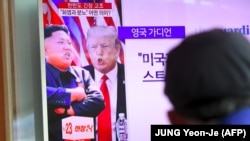North Korea said on August 9 that it is "carefully examining" plans to launch a missile strike on the U.S. Pacific island of Guam hours after U.S. President Donald Trump warned Pyongyang that any threats would be met with "fire and fury."
North Korea has said its goal is to develop a nuclear-tipped missile capable of striking the United States and has shrugged off international sanctions aimed at forcing it to halt its nuclear and missile programs.
A strike by a medium-to-long range strategic ballistic missile could be launched toward Guam at any moment once leader Kim Jong Un makes a decision, a spokesman for the Korean People's Army said in a statement carried by the North's state-run KCNA news agency.
The spokesman said the strike would aim to "contain the U.S. major military bases on Guam." Guam is a critical outpost for the United States to launch military missions in the Asia-Pacific region.
North Korea also accused the United States of preparing a "preventive war" which it said would turn into an "all-out war wiping out all the strongholds of enemies, including the U.S. mainland."
Trump earlier had warned Pyongyang of dire consequences from threatening the United States.
"North Korea best not make any more threats to the United States,” Trump told reporters at his golf course in the U.S. state of New Jersey. “They will be met with fire and fury like the world has never seen."
Trump issued the warning after a Washington Post report said Pyongyang had produced a miniaturized nuclear warhead that can fit inside its missiles -- a key step in the country's attempt to become a full-fledged nuclear power.
The rhetoric between the White House and Pyongyang has heated up dramatically after North Korea tested two intercontinental ballistic missiles in July, taking a significant step toward its goal of developing a long-range missile capable of striking anywhere in the mainland United States.
The UN Security Council on August 5 unanimously imposed new economic sanctions on North Korea, aimed at pressuring Pyongyang to end its nuclear program.
North Korea said the sanctions infringed its sovereignty and warned that it was ready to give Washington a "severe lesson" with what it called its strategic nuclear force in response to any U.S. military action.
On August 8, The Washington Post reported that U.S. intelligence officials assess that North Korea has produced nuclear weapons for ballistic missile delivery, including by intercontinental missiles.
https://www.washingtonpost.com/world/national-security/north-korea-now-making-missile-ready-nuclear-weapons-us-analysts-say/2017/08/08/e14b882a-7b6b-11e7-9d08-b79f191668ed_story.html?hpid=hp_hp-top-table-main_nkorea-1212p%3Ahomepage%2Fstory&utm_term=.8eb95f9ad808
The article, citing unnamed U.S. intelligence officials, said the confidential analysis was completed by the U.S. Defense Intelligence Agency last month.
It said it was not known if North Korea had successfully tested the smaller warhead design, although North Korea last year claimed to have done so.
The Post also reported that another intelligence assessment estimated that North Korea now has “up to 60 nuclear weapons,” more than previously thought.
Meanwhile, the Defense Ministry of Japan, a key U.S. ally, concluded in an annual white paper released on August 8 that "it is possible that North Korea has achieved the miniaturization of nuclear weapons and has developed nuclear warheads."
North Korea has ignored international calls to halt its nuclear and missile programs.
It says its ballistic missiles are a legitimate means of defense against perceived U.S. hostility and accuses the United States and South Korea of escalating tensions by conducting military drills.





